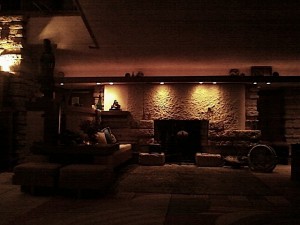The one thing you can almost never tell an artist friend is that you don’t like his art. It’s dicey merely to say that you don’t understand a particular work, much less that it doesn’t speak to you (even if you go out of your way to assure him that the failing is yours). It’s all but impossible to have a friendly relationship, or even a cordial one, if you simply don’t respond to anything he does. In some cases this is a function of the artist’s vanity, but I’m sure that more often it has to do with his deep-seated uncertainties….
Read the whole thing here.




 The conceit of “Mother of the Maid” is that the Arcs, though dressed in 15th-century attire, speak in the rough-hewn manner of a modern-day working-class British family, while St. Catherine (Bridget Saracino), the spectral narrator, sounds like a wisecracking millennial whose casual flippancy (“O.K, that went well”) allows skeptical viewers to keep the play’s religious content at arm’s length. Not that it’s hard to do so in any case, for “Mother of the Maid” is less about martyrdom than motherhood, and specifically about the yawning chasm of class and comprehension that opens up when an ordinary parent bears a gifted child who gradually turns (in Isabelle’s anguished words) into “something that’s taller and smarter than you will ever be.”
The conceit of “Mother of the Maid” is that the Arcs, though dressed in 15th-century attire, speak in the rough-hewn manner of a modern-day working-class British family, while St. Catherine (Bridget Saracino), the spectral narrator, sounds like a wisecracking millennial whose casual flippancy (“O.K, that went well”) allows skeptical viewers to keep the play’s religious content at arm’s length. Not that it’s hard to do so in any case, for “Mother of the Maid” is less about martyrdom than motherhood, and specifically about the yawning chasm of class and comprehension that opens up when an ordinary parent bears a gifted child who gradually turns (in Isabelle’s anguished words) into “something that’s taller and smarter than you will ever be.” In today’s Wall Street Journal “Sightings” column I report on the night I recently spent in
In today’s Wall Street Journal “Sightings” column I report on the night I recently spent in  The hillside living quarters, originally built in 1911, were ravaged by fire and rebuilt in 1914 and 1925, after which Wright spent the rest of his long life tinkering with Taliesin, which he used as a kind of living sketchbook. It was there that he experimented with devices later employed in homes designed for his clients, incorporating other touches strictly for his amusement, the most fanciful of which is a vertigo-inducing cantilevered walkway that juts out from the living room. I tried to walk all the way to the far end at midnight, and turned back after a few shaky steps.
The hillside living quarters, originally built in 1911, were ravaged by fire and rebuilt in 1914 and 1925, after which Wright spent the rest of his long life tinkering with Taliesin, which he used as a kind of living sketchbook. It was there that he experimented with devices later employed in homes designed for his clients, incorporating other touches strictly for his amusement, the most fanciful of which is a vertigo-inducing cantilevered walkway that juts out from the living room. I tried to walk all the way to the far end at midnight, and turned back after a few shaky steps. At length I retired to the stucco-and-stone guest bedroom, a smallish space with unexpectedly high ceilings (Wright appears to have designed many of his buildings with his own small stature in mind). Its simple furnishings include another hearth, a desk, a reasonably comfortable bed and a bookshelf containing a quirky but somehow characteristic selection of volumes…
At length I retired to the stucco-and-stone guest bedroom, a smallish space with unexpectedly high ceilings (Wright appears to have designed many of his buildings with his own small stature in mind). Its simple furnishings include another hearth, a desk, a reasonably comfortable bed and a bookshelf containing a quirky but somehow characteristic selection of volumes… As I sat in the living room of Taliesin at midnight, it occurred to me that it would be appropriate for me to listen to a piece of music that Frank Lloyd Wright would have liked, so I fetched my iPod, plugged in my travel speaker, and played the Busch String Quartet’s 1941 recording of the cavatina from Beethoven’s B Flat Quartet, Op. 130.
As I sat in the living room of Taliesin at midnight, it occurred to me that it would be appropriate for me to listen to a piece of music that Frank Lloyd Wright would have liked, so I fetched my iPod, plugged in my travel speaker, and played the Busch String Quartet’s 1941 recording of the cavatina from Beethoven’s B Flat Quartet, Op. 130.